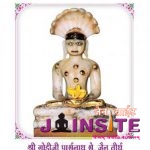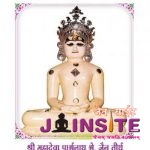Mulnayak: Nearly 68 cms. high, white – coloured idol of Bhagwan Hamirpura Parshvanath in the Padmasana posture.
Tirth: This temple is situated amidst a forest that is surrounded by hills on three sides 2 kms. away from the Mirpur village.
Historicity: It is stated that this city was founded by Devda Hamir in Vikram year 808 and came to be known as Hamirpur. This city was also known as Hamirgadh as there was a strong fort here. The Jain Temple was built in the 9th century AD, during the reign of the Rajputs. This temple is generally thought to be the oldest marble monument in Rajasthan. There is an inscription stating that this temple was built by King Samprati. A reference is there mentioning the temple being renovated by Shri Samant, the disciple of Acharya Jayanandsurishvarji in V.S. 821. The scattered relics over here reveal that this was a large and prosperous city at one time. This temple was destroyed by Mahmud Begada in the 13th century, and was rebuilt and renovated in the 15th century. On the pillars of the temple, there are inscriptions of the period of renovations done during the Vikram year 1550 and 1556. This is the birth-place of Shri Parshvachandrasuri Maharaj Saheb, the founder of Parshvachandra gachchha who was born in V.S.1537. A fair is held here every year on the tenth day of the dark half of the month of Paush, Chaitri Purnima and Karthik Purnima. These days only the main temple with its mandapa is standing, high on its pedestal with carved pillars and engraved parikrama representing every aspect of Indian mythology. This temple is also mentioned in the “World And Encyclopedia of Art”. This temple was recently renovated. Today, Hamirpur is known as “Mirpur”.
Other Temples: Besides this temple, there are three more temples at present.
Works of art and Sculpture: The art of this place is matchless. It is believed that the sculpture of domes, arched gates and pillars is more than thousand years old. The carving of elephants in the temple seems to be the best work of art of the times of Pallava. The art of construction shown in building up the sikhar here is different from that of even mt.Abu. This shrine has its special significance because of its unique solitary atmosphere, its art and its age. The figures of yaksha, gandharvas, gods and goddesses all around are very intricately carved. The indescribable artistry of this temple is famous throughout the world and is considered by many to be unmatched. It is said that the artistry displayed on the summit here surpasses even that of the temples of Mt.Abu. The corners and sides of the plinth of this temple even stand on sculpted elephants. The ancient sculpture of this temple reminds one of mt. Abu, Delwada etc..The ever-peaceful atmosphere of this lonely place is very beautiful. Its natural beauty and the scene of sun-set in front of the temple is spectacular.
Guidelines: The temple is at a distance of 37 kms. from the nearest railway station of Sirohi, at a distance of 60 kms. from Abu and at a distance of 15 kms. from the Sirohi town. Bus service and private vehicles are available. Dharamshala and Bhojanshala facilities are available here. Diyana, Lotana, Nandiya, Ajhari, Jiravala Tirth are close by from here.
Scripture: This temple is mentioned as built by Raja Samprati in a composition entitled “Virvanshavali”. In the handwritten manuscript of the laudatory poem “Shatpadika”, a mention is made about the local Palliwal Shreshthi’s. It was here that in Virkam year 1576, Sri Saubhagyasuriji, chief disciple of Sri Indranadsuriji of Tapa Gachchha had composed the story of “Maun Ekadashi”. A mention of Hamirpura Parshvanath is made in “Shri Sankheswar Parshvanath Chaand”, in “108 Naam Garbhit Parshvanath Chaand”, in “Tirthmala” etc. An idol of Hamirpura Parshvanath is there in Kalikund Parshvanath temple in Santacruz, Mumbai.

Trust: Shri Mirpur Parshvanath Shwetambat Jain Tirth, Post: Mirpur – 307 001. District: Sirohi, Rajasthan State, India. Phone: 02972 – 286737.
श्री हमीरपुरा पार्श्वनाथ
श्री हमीरपुरा पार्श्वनाथ – श्री मीरपुर तीर्थ
वि.सं. ८०८ में हमीर द्वारा इस गाँव को बसाने का उल्लेख है| इसका हमीरपुर, हमीरगढ़ के नाम से भी उल्लेख मिलता है|लेकिन यह मंदिर इससे भी प्राचीन है| वि.सं. ८२१ में आचार्य श्री जाया नन्दसूरीश्वर्जी के सदुपदेश से मंत्रीश्वर श्री सामन्त, द्वारा इस मंदिर का जिणोरद्वार करवाने का उल्लेख है| यहाँ पर गम्बुजो, तोरणों व स्तंभों आदि पर की गयी शिल्पकला लगभग हजार वर्ष प्राचीन मानी जाती है| हो सकता है एक हजा वर्ष पूर्व जिणोरद्वार होकर शिल्पकला के नमूने स्तंभों आदि पर प्रस्तुत किये गये हो| सं. १३२८ में हस्तलिखित “शपतदिका” प्रश्स्ति में भी यहाँ के पल्लिवाल क्षेष्ठियो का उल्लेख आता है| किसी समय यह एक विराट नगरी रही होगी, ऐसा यहाँ इधर-उधर बिखरे अवशेषों आदि से अनुमान लगाया जाता है|
यहाँ की प्राचीन शिल्पकला देखते ही आबू-देलवाडा, कुम्भारिया का स्मरण हो आता है| यहाँ शिखर पर उत्कीर्ण कला तो आबू से भी निराली है| यह तीर्थ अपनी प्राचीनता, कला व अद्धितीय वातावरण में एकान्त स्थान पर होने के कारण अपना विशेष स्थान रखता है| प्रतिवर्ष पौष कृष्णा १०, चैत्री पूर्णिमा व कार्तिक पूर्णिमा को मेले लगते है|
तपागच्छीय श्री इन्द्रनन्दसूरीजी के पट्टधर श्री सौभाग्यनंदीसूरीजी ने यहीं पर वि.सं. १५७६ में श्री मौन एकादशी की कथा रची थी| “वर्ल्ड एनसाईक्लोपेडिया ऑफ़ आर्ट” में भी इस मंदिर का उल्लेख है|







